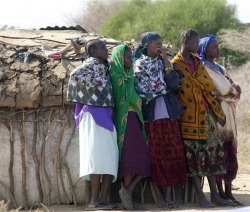Kenya: Indigenous Ethnic Groups

Isabelle Smeekes
World History -Hjelmgren
5/7/09, period 4
Kenya: Indigenous Ethnic Groups
Many of the oldest skeletal forms were found in Kenya, some over 20 million years old! These humans were most likely a part of an indigenous ethnic group (US Library of congress). All over Africa there were, and currently are, many ethnic groups. In Kenya there are about 42 census-designated ethnic groups (Solberg-Ayers, 1). The largest Group, of about 8 million people, is known as the Kikuyu. The Kikuyu group lives in the Mount Kenya area; they are thought to have migrated to Mount Kenya from the northeast in the 17th century. According to Shari Solberg-Ayers, “The Kikuyu were very actively involved in the fight for freedom and independence in Kenya, and today they remain a dominant culture in the national political, commercial and agricultural spheres”(Solberg-Ayers,1). There are also other groups that are smaller and they are all about 10 to 15% of the population, such as the Luhya, Luo, Kamba and Kalenjin. With the Kikuyu these groups all together account for three-quarters of Kenya’s population. The rest of Kenya’s population is made up of many smaller groups.
All of the ethnic in Kenya groups were greatly affected by the slave trade and European colonization. In the 7th century the Arabs and Persians took over and started using slaves (Koopman). Obviously, none of the Kenyans like this, but there were no people who really started to protest (Koopman). Then in 1498 explorer Vasco de Gamas came to explore. In 1525 he came back and brought the Portuguese along with him and they conquered Mombasa, and they still continued to use and trade slaves (US Library of congress). And in 1885 the British took over and continued the slave trade (Koopman). In the 1920s the British made Kenya a British crown colony, and at the same time the Africans started to protest, the protests peaked between 1952 and 1956 (US Library of congress). Eventually in 1959 the British put Kenya under a state of emergency (US Library of congress). They imprisoned Jomo Kenyatta, one of the Kikuyus who was an activist since the 1920s, and many other of the colony’s nationalist leaders (Koopman). Finally Kenya became independent on December 12th, 1963 and in 1964 Kenya became a republic (US Library of congress).
Today there is peace and there are still separate ethnic groups. The groups get along, trade, and some even inter-marry. Many of the ethnic groups still exist such as the Kikuyu. Now there are also more refugees, Shari Solberg-Ayers said, “According to the United Nations high commissioner for refugees, as of January 2008, an estimated 378,000 refugees were also living in Kenya, of whom 197,000 were Somalis fleeing chaos in neighboring Somalia. Other large refugee populations hail from Sudan and Ethiopia” (Solberg-Ayers, 1). Besides the increase of more refugees in the population there are no other drastic changes in Kenya’s ethnic groups. There is now peace with Kenya’s ethnic indigenous groups.
Bibliography
Koopman, Arjen. “Kenya History: Introduction.” 2009. <kenya-fgjjgkjgdfakfdklfjj;advisor.com>http://www.kenya-advisor.com/kenya-history.html
* This website was very helpful for the reason that it gave information on the history of Kenya and its people.
Macdonald, Fiona, et al. "Kenya." 2001. Peoples Of Africa. Ed. sdjfsjdfkjasdfMarian Armstrong. Vol. 5. Peoples of Africa. Tarrytown, New York: Marshall Cavendish Corporation, 2001.
* This book was useful because it provided information on a few of the bigger ethnic groups.
Solberg-Ayers, Shari. "Kenya: People." World Geography. 2009. ABC-fkdjjsdljfasldf CLIO.Apr. 2008 jfaskldfjksldfkl<http://www.worldgeography.abc-clio.com>. http://www.worldgeography.abc-clio.com/Countries/Display.aspx?categoryid=45&entryid=1114812&searchtext=the+people+of+kenya&type=simple&option=all&filterid=
* This site was helpful because it had information on the major ethnic groups and the backgrounds of the groups.
United States. United States Library of Congress. "Library of Congress – ld;’sfk;s’kdf’;kfk;FederalResearch dsfdfsfasdf Division Country Profiles." Library of Congress – Federal Research Division Country Profile: Kenya. 24 pages. lcweb2.loc.gov. June 2007. Library of Congress. 28 Apr. 2009 <http://lcweb2.loc.gov/frd/cs/profiles/ Kenya.pdf>.
*This website was extremely helpful because it provided a lot of information about the overall history of Kenya including, slavery and colonization.
Last updated by Isabelle Smeekes on May 22, 2009

